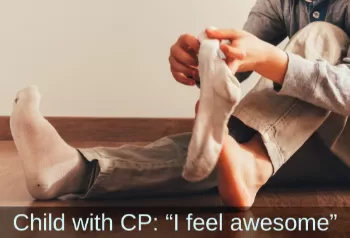Primitive Reflex Integration Case Studies
11-Year-Old with Hemiparesis Makes Gains at Every Session
Boy with Cerebral Palsy improves gross motor skills, core stability, and behavioral issues.
This young boy with pachygyria, schizencephaly, cerebral palsy has poor body control and core strength, as well as poor emotional regulation and a reluctance to try new skills. Find out how rhythmic movements introduced a calm that allowed him to improve his fine and gross motor skills.
Submitted by Laura Thaw, OTR/L

| Before | After |
|---|---|
| Poor emotional regulation | Calmer behavior |
| Resisted anything difficult or challenging | More willingness to try new, challenging tasks |
| Would forget functional use of the left UE, and postures the shoulder and arm to compensate for poor core stability | Spontaneous skilled use of the left upper extremity in play, i.e., reciprocal arm movements when playing a drum with mallets |
| Challenges completing tasks that require both hands | Sudden improvement in ability and ease to don socks and shoes |
| Difficulty with transitions | Smoother transitions with fewer meltdowns |
Max is an 11-year-old boy with diagnoses of Pachygyria, Schizencephaly, Cerebral Palsy; he has left side hemiparesis with spasticity in the upper and lower extremity. I have been working with him in a private outpatient clinic, mostly weekly, since he was 3 years old. Max is verbal and ambulatory, but has developmental delays, poor body and self awareness, and poor attentional and emotional regulation. He has difficulty processing and communicating feelings and needs. He has difficulty with transitions, is frequently sleepy in school, and resists anything difficult or challenging. Though he has functional use of the left UE, he often forgets about it, and postures the shoulder and arm to compensate for poor core stability. He struggles with reading, writing and math concepts, but is highly imaginative and has a bright, joyful sense of humor when he is feeling good and regulated. I have observed unintegrated primitive reflexes in Max for years, most notably ATNR, Moro, TLR, palmar Babkin, and Babinski (Possibly all are unintegrated to some degree). We have been using developmental activities for reflex integration for a long time, but the rhythmic movements [from the Brain and Sensory Foundations course] have been an additional piece to his program. Goals include increasing core stability, increasing spontaneous use of the left upper extremity in functional activities, improving emotional regulation as it relates to transitions and participation with non-preferred tasks, and increasing independence with dressing and hygiene.
From the moment we started using RM, Max was “all in”. He loves them and often exclaims things like “I feel awesome!” afterwards. Max has participated with all 4 rhythmic movements intermittently over the past 6 months, along with reflex stimulation and integration activities (addressing the reflexes stated above) and he appears to benefit from all.
Every time, he is calmer, has a soft smile, and appears more relaxed. His attendance to therapy is, at times, inconsistent, but gains are observed at every session, either within the session or mother will report something positive that occurs following therapy. Improvements have included an increase in calm behavior and willingness to try a new challenging task, spontaneous skilled use of the left upper extremity in play, i.e., reciprocal arm movements when playing a drum with mallets, a sudden improvement in ability and ease to don socks and shoes, and smoother transitions with fewer meltdowns.
Mother attended a training session to learn the rhythmic movements so that they could continue them at home.
[Edited for length and clarity; emphasis added]
*Disclaimer: The activities in the Brain and Sensory Foundations curriculum make use of the natural processes of neuroplasticity and development that are innately wired in the design of human beings to promote maturity and function. These activities appear to calm, organize, and mature the neuro-sensory-motor systems just as we see in the healthy development of human infants. Individual results may vary, and we do not claim to offer a diagnosis or cure for any specific condition or disorder. The Brain and Sensory Foundations activities appear to improve overall functioning resulting in measurable improvements for a range of conditions as demonstrated in over 1800 case studies from participants.

